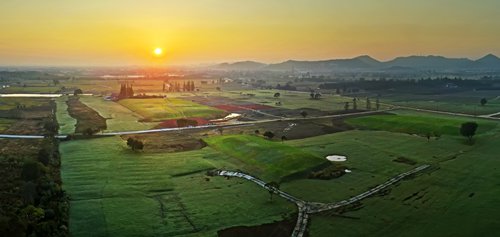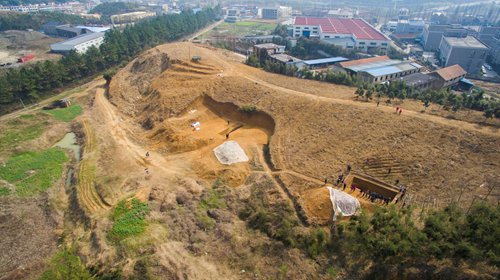
The Liangzhu city palace dig site (Photo/Courtesy of Li Xingli)
China recommends Liangzhu archeological site for World Heritage List
When a seemingly nondescript Chinese town suddenly becomes quite well-known across the planet, the reason is easy to guess: history.
As a historic town, the Liangzhu archeological site became famous for its Neolithic jade culture in the Yangtze river delta.
Since 1936 when the first stoneware was excavated at Liangzhu, the town has made headlines across the world for the magnificent scale of its tombs, its jade treasures and later its ancient dams.
China on January 26 recommended Liangzhu archeological site as a candidate for World Heritage status in 2019, bringing this ancient city back under the spotlight again.
Liangzhu proved what many Chinese have always wanted to believe and often speculated: Chinese culture is more than 5,000 years old.
"It was once just a deduction according to historical records," says Wang Ningyuan, a researcher at the Zhejiang Provincial Institute of Cultural Relics and Archaeology, "but now we have found proof of early civilization."
The discovery of Liangzhu "can fill the blank space" in Neolithic archeological work as it represents the earliest stage of Chinese civilization, "and played an outstanding role in the 5,000 year development of Chinese agricultural civilization," Chen Shoutian, site management committee deputy director, told the Global Times.
Origin of civilization
Located in a wetland environment on the plain of river networks between Mount Daxiong and Mount Dazhe of the Tianmu mountain range, the ancient city of Liangzhu offers profound and compelling evidence of early civilization, Chen said.
"Tracing back 5,300 years, a nation was established by a group of people living near the ancient city of Liangzhu. With abundant sources of food, their kingdom covered 36,000 square kilometers along Lake Taihu.
"Surprisingly, they stepped into early civilization as they developed a rice agricultural system and shared a common faith. Also according to the archeological evidence, social divisions appeared."
From 2009-2012, a geographic information system (GIS) helped Zhejiang Provincial Institute of Cultural Relics and Archaeology to analyze the geological structure of the site, explained institute director Liu Bin.
"We confirmed there was an outer city wall consisting of various hills and villages," he said. "Also, the ancient city includes structures for a palace, inner city and outer city, recognized as the typical structure of an ancient Chinese capital."

The city's advanced irrigation stunned the world.
"From 2009 to 2015, new techniques were applied to our research. Through RS (remote sensing) and GIS, also through knowledge of hydraulic engineering, archeologists discovered a hydrological system outside the city that controlled up to 100 square kilometers for more than 5,000 years.
It was the world's earliest hydrological system, designed to protect the city from floods, Liu said.
"From 2008 to 2017 we had a new breakthrough in the inner part of the city, including its river network, palace zone, the emperor's tomb, granary and workshop," Liu said. "Surprisingly the city boasts urban planning with different zones performing different functions well. Urban residents mainly worked on producing jade ware, stone ware and other vessels, while rural people did something totally different."
From this archeologists could deduce social strata, Liu said.
More than 160 sites were discovered in the suburbs of the ancient city in the last nine years, doubling the total historical sites.
Through Carbon-14 testing, archeologists could date the hydrological system and tombs as between 5,300 and 4,200 years old.
World significance
Liangzhu has attracted attention outside China. British archeologist Colin Renfrew visited Liangzhu on March 21 last year and said Liangzhu culture was unique and complex, providing a new opportunity for archeologists to consider ancient civilizations.
The development of water transportation in the ancient city was rarely seen in Mesopotamia, a fact that may inspire researchers to look at Chinese and global cultures in a totally new way, he said.
Some 23 experts from all over the world participated in archeological work at Liangzhu. All were amazed. English art historian Jessica Rawson said the site was of great importance to world heritage.
Liangzhu would make contribute three key contributions to world heritage, Chen said.
"Firstly, it provide evidence of history," he said. "Secondly, it is an authentic historical site based on the archeological excavations, which reveals the real city dates back to 5,000 years ago.
"Last but not least, it is well preserved and can set an example for Chinese historical sites."


















































